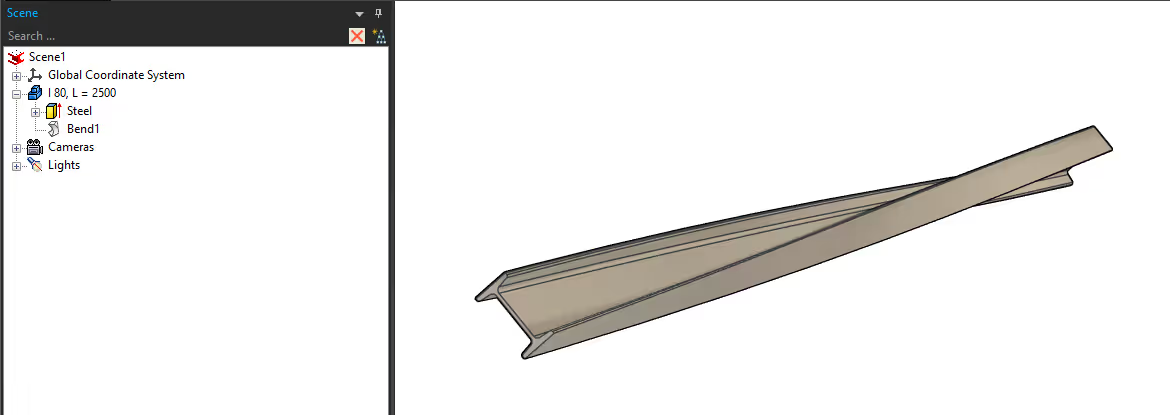Download Centre

Looks like you don't have ESC button on your device
Download IronCAD DCS
Choose one of the following options
trial versionHas a license.avif)

Emil Rindell

Jonas Bryntesson

Henrik Andersson
2025-04-24

Emil Rindell

Jonas Bryntesson

Henrik Andersson
2025-04-24
IRONCAD 2025 comes packed with smart innovations - and one of the new features is the new Bend tool. This feature allows you to bend or twist a model with just a few clicks. The tool works as a new feature you apply to a part - for example, if you want to give an H-beam a fixed radius or twist it along its axis.
You can find the tool under the tab Assembly tab (although perhaps it should have been under the Featuretab, Transform group). Then use TriBall to easily determine the centerline of the bend or twist - you can control exactly where and how the model deforms.
Examples of what you can do:
Click on the part followed by Bend. Then you can control the bend via Angle or Radius.

After executing the tool, you will have a new feature under the part called "Bend". To edit the settings, right click on Bend>Edit Feature Options

Under Bend Regions, you can control the distance at which the bend should start and/or end.


Click on the party followed by Twist. Then you can control the bend via Angle or Radius.


Same as for Bend, under Bend Regions you can control the distance at which the twist should start and/or stop.


The Bend tool is not only easy to use - it's also a powerful complement to classic features like Sweep and Loft. In some cases, it can even replace them completely. For example, do you need to create a curved shape with a constant cross-section or a spiral structure? With Bend and Twist, it's both faster and more intuitive than before.
Answer: Here we publish tips, guides, news and solutions for those who work with IRONCAD and Design Data Manager (DDM). The blog covers everything from basic functions to advanced workflows, helping you to optimize your design work. You'll find examples of smart shortcuts, practical instructions, solutions to common problems, and best practices for product design, mechanical design, and product data management.
Answer: Our guides and tips are designed for both beginners and experienced CAD users. They are aimed at designers, engineers and project managers who want to work more efficiently with IRONCAD and DDM, improve the design process, reduce mistakes and save time in product development.
Answer: We regularly publish new articles when the software is updated, when new features are introduced, or when our users ask for solutions to specific problems. The blog is therefore a reliable source for keeping up to date and getting tips that make everyday CAD work easier.
Answer: Many of our instructions and tips work in multiple versions, but we clearly indicate if an article applies to a specific version. We strive to make the content useful for older versions as well, and also provide recommendations on how to adapt workflows to the version you are using.
Answer: Absolutely! If you can't find the solution in the blog, you can contact our technical support via solidmakarna.support. Our experts will help you with everything from installation and configuration to advanced features in IRONCAD and DDM, so you can solve problems quickly and efficiently.
Answer: Yes! We appreciate suggestions from our users. If you have questions, tips or want us to address a specific issue in IRONCAD or DDM , please contact us via our contact form and we will prioritize relevant topics in future posts.
Answer: The blog contains, among other things:
Practical step-by-step guides to help you use IRONCAD and DDM more effectively.
Productivity and workflow tips for faster design and construction.
Solutions to common problems encountered by users in CAD programs.
Updates and news on new features, versions and improvements.
Best practices for data management and project organization in DDM.
Answer: All tips and guides are directly applicable in daily work. For example, you can use shortcuts and smart features in IRONCAD to speed up modeling, structure files better in Design Data Manager, or follow our step-by-step solutions for specific problems that often come up in design projects.
Answer: We strive to ensure that all guides and tips are relevant to the latest versions of IRONCAD and DDM. We also clearly mark when a post applies to an older version, so you always know if the instruction is directly applicable to your system.
Answer: Yes! Many of our users share the articles with colleagues and use them as internal training materials. The blog is a great complement to formal training and helps teams learn features faster, avoid mistakes, and standardize workflows in IRONCAD and DDM.